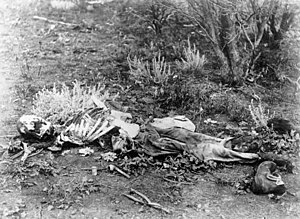Forensic anthropology

Forensic anthropology is the application of the science of physical anthropology and human osteology (the study of the human skeleton) in a legal setting, most often in criminal cases where the victim's remains are more or less skeletonized. A forensic anthropologist can also assist in the identification of deceased individuals whose remains are decomposed, burned, mutilated or otherwise unrecognizable. The adjective "forensic" refers to the application of this subfield of science to a court of law.
There are few people who identify themselves as forensic anthropologists, as most practitioners are consultants who generally work full time in another capacity, as a professor in biological anthropology or in an allied forensic or museum setting.
The discipline
Forensic anthropology is a subdiscipline within the subfield of physical anthropology. Anthropology is typcially comprised of three subfields: cultural anthropology, archaeology, and physical (aka biological) anthropology. Some people still include linguistics as a fourth subfield, but more commonly this area is being absorbed by the other three.
Other disciplines in physical anthropology: genetics, human growth and development, primatology (study of primates), paleoanthropology (primate and human evolution), human osteology (study of the skeleton), paleodemography (vital statistics of past populations), skeletal biology, nutrition, dental anthropology, human adaptation and variation (to different climates, altitudes, etc.)--and this is just to name a few...
Forensic anthropology is an "applied" area. It borrows methods and techniques developed from skeletal biology and osteology and applies them to cases of forensic importance. Forensic means "legal."
Methods and techniques to assess age, sex, stature, ancestry, and analyze trauma and disease are generally developed to help anthropologists understand different populations living all over the world at different times throughout history. When we take these methods and apply them to unknown modern human remains, with the aim of establishing identity or manner of death, then we are practicing the forensic application of osteology. Forensic anthropologists frequently work in conjunction with forensic pathologists, odontologists, and homicide investigators to identify a decedent, discover evidence of foul play, and/or the postmortem interval. Forensic anthropologists do not determine cause of death of victims but their opinions may be taken into consideration by the coroner with the proper legal authority to do so. The testimony of the anthropologist as an expert witness to the court relies on the training and scientific expertise of the anthropologist.
A forensic anthropologist may be called in when human remains are found during anthropological or archaeological excavation, or when badly decomposed, burned, or skeletonized remains are found by law enforcement or members of the public. The identification of skeletal, badly decomposed, or otherwise unidentified human remains is important for both legal and humanitarian reasons. The anthropologist can assess Metric and nonmetric characteristics of the bones to determine the minimum number of individuals, sex, stature, age at death, time since death, ancestry and race, health, and unique identifying characteristics such as healed breaks or surgical scars. Sometimes the forensic anthropologist must determine whether the remains found are actually human. Many times, positive identification can be established from such remains, but often only an exclusionary identity can be drawn.
In physical trauma analysis, a forensic anthropologist attempts to determine whether sharp force, blunt force, or gunshot injury occurred before death (antemortem), near the time of death (perimortem), or after death (postmortem). If weapon use is found, the type of weapon or tool used may be determined by examining the marks left upon the bones. Even cremated remains can provide a surprising amount of information about the deceased individual.
Forensic anthropology in the United States
Forensic anthropology is one of the divisions of the American Academy of Forensic Sciences.
Two of the most important research collections of human skeletal remains are the Hamann-Todd Collection, now housed in the Cleveland Museum of Natural History and the Terry Collection, now housed in the Smithsonian Institution. These collections are an important historic basis for the statistical analysis necessary to make estimates and predictions from found remains. More modern collections include the University of Tennessee Forensic Anthropology Facility and the William M. Bass Donated Skeletal Collection at the University of Tennessee at Knoxville.
Forensic anthropologists of note
- Thomas Dwight (1843 - 1919)
- Ales Hrdlicka (1869 - 1943)
- Earnest Hooton (1887 - 1954)
- Mildred Trotter (1899 - 1991)
- T. Dale Stewart (1901 - 1997)
- Wilton M. Krogman (1903 - 1987)
- Ellis R. Kerley (1924 - 1998)
- Clyde Snow (1928- )
- William M. Bass (1928- )
- J. Lawrence Angel (1932 - 1988)
- William R. Maples (1937 - 1997)
- Karen Ramey Burns (1947 - )
- Richard L. Jantz
- Douglas H. Ubelaker
- Sheilagh T. Brooks
- Jane E. Buikstra
- Kathy Reichs
- William C. Rodriguez
- Marcella Sorg
- Judy M. Suchey
